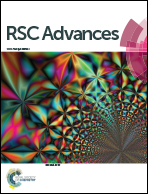Sintering mechanism of the Cu–Ag core–shell nanoparticle paste at low temperature in ambient air†
Abstract
Copper (Cu) nanoparticle (NP) paste has emerged as a promising choice for future high power electronics. However, the application of CuNP paste is generally limited because of its easy oxidation and complex processing parameters such as high sintering temperature (∼400 °C) and necessary protection atmosphere. Although capping CuNPs with a stable layer to form core–shell NPs could improve its anti-oxidation ability, current coating methods usually required complex equipment and protection atmosphere, and there have been no reports of fabricating joints with core–shell NPs. In this paper, Cu–silver (Ag) core–shell NPs with a unique structure, i.e., tiny AgNPs with an average diameter of 6.9 nm which almost completely cover the surface of initial smooth CuNPs, after first developing them in ambient air and then using a mild two-step method, are reported. After coating the tiny AgNPs on the surface, not only was the anti-oxidation ability improved during keeping (∼2 months), but also the sintering temperature of NP paste was lowered ∼70 °C. Through in situ observation during sintering, it was found that the tiny AgNPs tended to pre-melt and pre-wet to form active quasi-liquid Ag films, after which the Cu–Ag core–shell NPs were joined by the first to be found pure Ag sintering necks. Furthermore, the application of the Cu–Ag core–shell NP paste was demonstrated by fabricating voidless joints with a shear strength of 26.5 MPa in ambient air at 250 °C, and this showed a good potential for the future applications in high power electronics.


 Please wait while we load your content...
Please wait while we load your content...